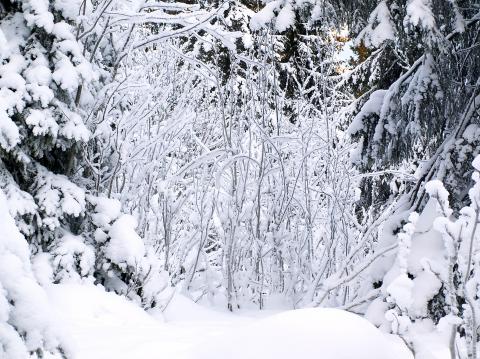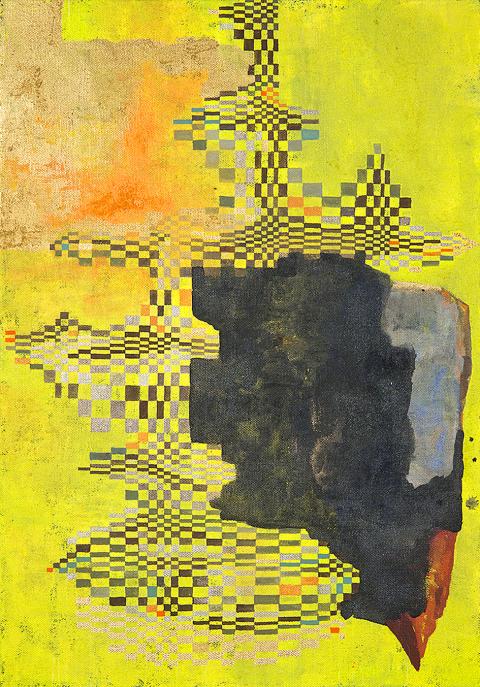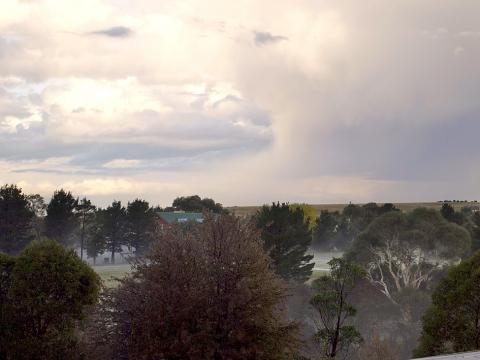The pairing of Denise Ferris and Ruth Waller for a dual exhibition at the National Taiwan University of Arts may seem like an odd one. Both artists are Australian and their work is inspired by nature, but while Ferris photographs snowy landscapes, Waller creates colorful abstract paintings.
When I meet with them on a rainy afternoon for coffee in Taipei, both artists recount, with much delight, their previous days’ activities as part of their jam-packed itinerary for their first trip to Taiwan. These included visiting a beach in Keelung and viewing Coral Stone Mountain, an exhibition at the Taipei Fine Arts Museum of the late artist Chen Shun-chu’s (陳順築) photographs of dilapidated buildings in Penghu.
They marvel over Taiwan’s natural beauty and talk about how they would incorporate it into art. Waller is fascinated by the rock motifs in Chinese paintings and Ferris says she couldn’t stop staring at the white foam which the waves created.

Photo courtesy of National Taiwan University of Arts
Being from Australia — Ferris is from Brisbane and Waller hails from Sydney, and both artists teach at the Australian National University in Canberra — it’s no wonder they love nature. Both Ferris and Waller possess a nerdy understanding of geology and minerals in an endearing sort of way — “it’s the twisting relationship between rocks and life,” says Waller about her paintings.
“People don’t usually think of connecting art and science,” she adds.
What their artwork has in common is “mattness and flatness,” as well as a sense of “materiality and immateriality,” Waller says.

Photo courtesy of National Taiwan University of Arts
Waller adds she was once “a purist painter.” In other words, she would only use paint and no other materials — “painting is a somewhat anachronistic activity in that sense,” she says.
But living in Canberra, “the bush capital” of Australia, it was easy to be inspired by natural materials. Plant forms and colors in botanical gardens have long featured in Waller’s artwork. Recently, though, her muse has been rocks. Waller likes the idea of how the shape and curvature of seemingly sedentary rocks can change due to the weather. She now incorporates this binary of static vs change in her artwork.
“I wanted to try something off-kilter and see how meaning can grow out of materials,” Waller says.

Photo courtesy of National Taiwan University of Arts
In order to achieve this, she started experimenting with layering paper mache and beads with paint. Her artwork, which has names such as Green December, Rocks 101 and Shimmer Shift, employ a lot of earthy colors and geometric lines. Certain parts of her paintings look two dimensional and other parts appear three dimensional.
The effect is to feel the presence of a plant or rock, even though the paintings do not actually depict those things.
EPHEMERAL SNOW
A similar feeling can be gleaned from Ferris’s photographs of beachscapes and snowscapes, which appear tangible yet glazed over. There’s a melting icicle here, a snowflake breezing past there, but there’s also a resolute stillness.
As Waller says of Ferris’s work, “the photographer works with an abstract eye.”
When I ask Ferris about her fascination with snow, she says that snow is a little cliche in art and that she wanted to present it in a different way. It might be cliche to claim that an artist steers away from cliches, but Ferris does a pretty good job at being an outlier.
In her early career, Ferris worked with milk prints, a nineteenth century printing technique. She made her prints white (in contrast to the natural tea-color hue that milk prints are), and for years she was surrounded by whiteness in her darkroom. Her prints were getting lighter and lighter until they were nearly disappearing — “they were crossing the threshold of visibility and invisibility,” she says.
Ferris adds that she first saw snow in Switzerland when she was 21 and has been enthralled by it ever since.
“Snow is ephemeral,” Ferris says. “It comes and it goes and you won’t know when it’ll come again.”
She is now a cross-country skier and is always ready with her camera whenever she’s on a ski trip to Norway or Switzerland. For Ferris, the progression from milk printing to photographing snow seemed natural. There’s a transcendent quality to both — a real sense of being there intertwined with a twinge of surreal. Or, as Ferris says, an “excessive whiteness leading to nothingness.”
For Ferris, it’s about conveying experience.
“A photograph doesn’t necessarily have to represent an absolute truth or an absolute thing,” she adds.
Her Navigation Series, which she shot while on skis navigating through a trail in Norway, is an example of this. Ferris says that this series in particular was meant to give her viewers a sense of what it was like on the journey — hence the “serial pictures of a singular thing.”
Unlike a painter, Ferris says she can’t add color or additional material to her “canvas,” so she has to utilize what she has at her disposal, which is a sense of “being there.” The result is a series of takes that, when viewed together, becomes almost like a reel.
Waller’s paintings and Ferris’s photographs are currently on display at the Yo-chang Arts Museum at the National Taiwan University of Arts in Banciao District (板橋區). The exhibition runs until April 25.

The unexpected collapse of the recall campaigns is being viewed through many lenses, most of them skewed and self-absorbed. The international media unsurprisingly focuses on what they perceive as the message that Taiwanese voters were sending in the failure of the mass recall, especially to China, the US and to friendly Western nations. This made some sense prior to early last month. One of the main arguments used by recall campaigners for recalling Chinese Nationalist Party (KMT) lawmakers was that they were too pro-China, and by extension not to be trusted with defending the nation. Also by extension, that argument could be

Aug. 4 to Aug. 10 When Coca-Cola finally pushed its way into Taiwan’s market in 1968, it allegedly vowed to wipe out its major domestic rival Hey Song within five years. But Hey Song, which began as a manual operation in a family cow shed in 1925, had proven its resilience, surviving numerous setbacks — including the loss of autonomy and nearly all its assets due to the Japanese colonial government’s wartime economic policy. By the 1960s, Hey Song had risen to the top of Taiwan’s beverage industry. This success was driven not only by president Chang Wen-chi’s

Last week, on the heels of the recall election that turned out so badly for Taiwan, came the news that US President Donald Trump had blocked the transit of President William Lai (賴清德) through the US on his way to Latin America. A few days later the international media reported that in June a scheduled visit by Minister of National Defense Wellington Koo (顧立雄) for high level meetings was canceled by the US after China’s President Xi Jinping (習近平) asked Trump to curb US engagement with Taiwan during a June phone call. The cancellation of Lai’s transit was a gaudy

The centuries-old fiery Chinese spirit baijiu (白酒), long associated with business dinners, is being reshaped to appeal to younger generations as its makers adapt to changing times. Mostly distilled from sorghum, the clear but pungent liquor contains as much as 60 percent alcohol. It’s the usual choice for toasts of gan bei (乾杯), the Chinese expression for bottoms up, and raucous drinking games. “If you like to drink spirits and you’ve never had baijiu, it’s kind of like eating noodles but you’ve never had spaghetti,” said Jim Boyce, a Canadian writer and wine expert who founded World Baijiu Day a decade